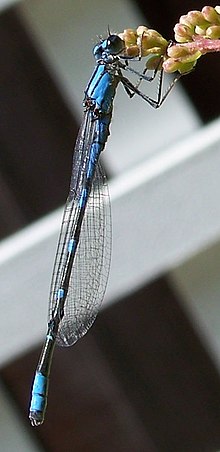| This article includes a list of references, related reading, or external links, but its sources remain unclear because it lacks inline citations. Please help improve this article by introducing more precise citations. (December 2019) (Learn how and when to remove this message) |
| Tule bluet | |
|---|---|

| |
| Conservation status | |
 Least Concern (IUCN 3.1) | |
| Scientific classification | |
| Domain: | Eukaryota |
| Kingdom: | Animalia |
| Phylum: | Arthropoda |
| Class: | Insecta |
| Order: | Odonata |
| Suborder: | Zygoptera |
| Family: | Coenagrionidae |
| Genus: | Enallagma |
| Species: | E. carunculatum |
| Binomial name | |
| Enallagma carunculatum Morse, 1895 | |
The tule bluet (Enallagma carunculatum) is a species of damselfly in the family Coenagrionidae found in North America, from northern Mexico to southern Canada.
Identification
The damselfly has a blue and black abdomen, usually with more black than blue. The black humeral stripes are about a half the width of the blue antehumerals. The tule bluet postocular spots are small and triangular; they are separated by a thin occipital bar.
Size
This bluet is 27–37 mm (1.1–1.5 in) long.
Distribution
The tule bluet is found throughout North America from southern Canada to northern Mexico, excluding the southeastern United States.
Habitat
The following is the list of habitats of the tule bluet.
- rivers
- lakes
- ponds
- marshes
- bogs
They occur where there are bulrushes around.
Flight season
Mid-May to mid-September. It can also be during early July to mid-October.
Diet
- Nymphs: nymphs eat a large variety of aquatic insects, they include mosquito larvae, mayfly larvae, and other aquatic insect larvae.
- Adults: adult tule bluet feed on a wide variety small flying insects, mayflies, flies, small moths, and mosquitoes. They sometimes pick up small insects from plants like aphids.
Ecology
The tule bluet is found almost always where there are extensive stands of tules. This is how this bluet gets its common name. The damselfly will emerge from relatively deep water if there are bulrushes nearby. The tule bluet can be also found in alkaline or salty water.
Reproduction
The male damselflies set up territories at choice breeding sites. After males and females have mated, the male stays attached to the female, as she oviposits in the stems of bulrushes. They are in their tandem position.
Conservation
The populations of the tule bluet are widespeard, abundant, and secure.
References
- Paulson, D. R. (2017). "Enallagma carunculatum". IUCN Red List of Threatened Species. 2017: e.T165079A65831144. doi:10.2305/IUCN.UK.2017-3.RLTS.T165079A65831144.en. Retrieved 15 January 2022.
- Tule Bluet
- Greg Lasley's North American Dragonflies and Damselflies
- Tule Bluet - Enallagma carunculatum
- Damselfly - Enallagma carunculatum - BugGuide.Net
- Lam, E. (2004) Damselflies of the Northeast. Forest Hills, NY:Biodiversity Books. p. 65.
| Taxon identifiers | |
|---|---|
| Enallagma carunculatum | |